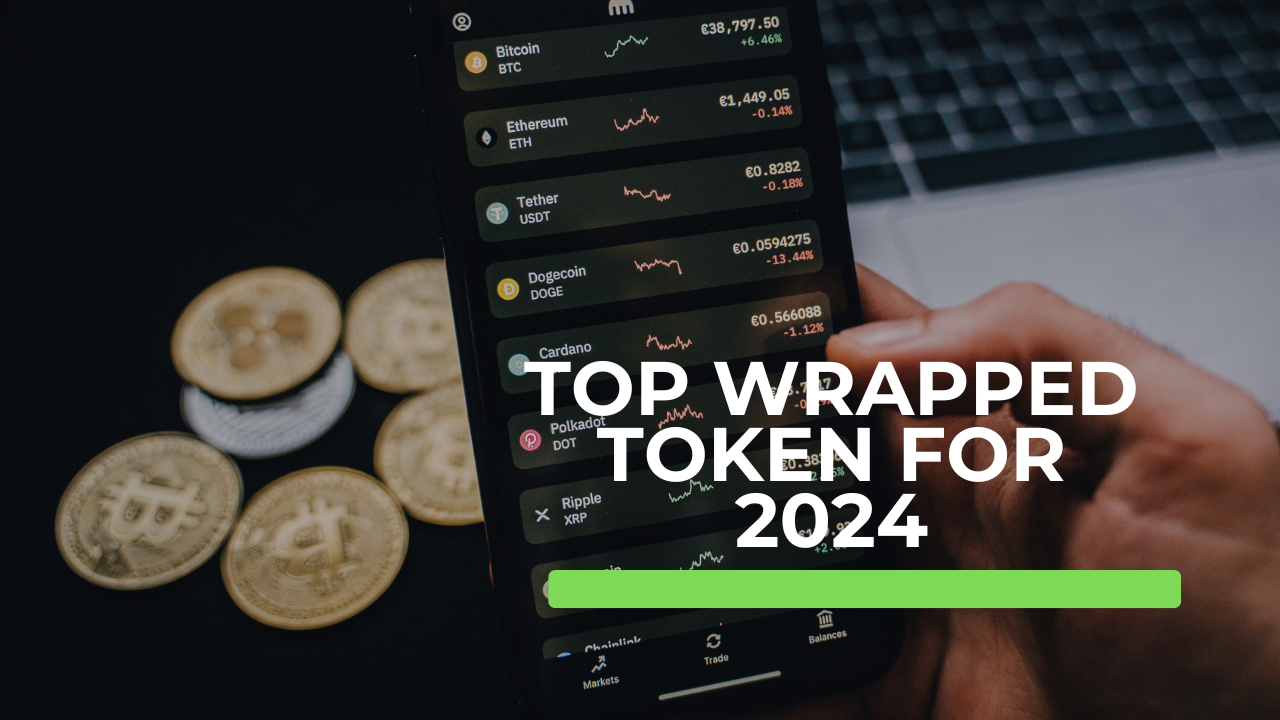Wrapped tokens, also referred to as wrapped coins, represent a tokenized version of an existing cryptocurrency, enabling it to operate on a different blockchain network. Essentially, these tokens are safeguarded by a digital “wrapper” or vault, preserving the value of the original asset while allowing it to function on another blockchain. This mechanism facilitates seamless interchangeability across various platforms.

How wrapped tokens function?
Representation and Conversion
- Wrapped tokens symbolize an underlying cryptocurrency or asset from a distinct blockchain or token standard.
- They are akin to a parallel rendition of the original asset but formatted to be compatible with a specific blockchain.
- For example, wrapped bitcoin (wBTC) represents an ERC-20 version of bitcoin.
Interoperability
- Wrapped tokens enhance interoperability between incompatible cryptocurrencies and blockchains.
- They enable assets like bitcoin and ether to be traded, lent, and borrowed on decentralized finance (DeFi) platforms.
- This fosters liquidity provision and broadens the utility of crypto assets.
Top 7 Wrapped-Tokens Coins to Look Out for in 2024
1. Wrapped Bitcoin (WBTC)
As the first and most popular wrapped token, WBTC brings the liquidity of Bitcoin to the Ethereum ecosystem. It allows Bitcoin holders to participate in decentralized finance (DeFi) applications on Ethereum. It is a tokenized version of Bitcoin built on the Ethereum blockchain, adhering to the ERC-20 standard. Its key feature is its 1:1 pegging to Bitcoin, maintained by a network of custodians who hold Bitcoin and issue WBTC tokens accordingly. BitGo is a notable custodian involved in WBTC issuance. WBTC facilitates seamless liquidity transfer between the Bitcoin and Ethereum networks. It can be traded on decentralized exchanges like Uniswap and used for various DeFi activities such as lending, borrowing, and yield farming. Governed by the WBTC DAO, it serves as a bridge connecting Bitcoin to Ethereum’s DeFi ecosystem, offering users access to a broader range of financial opportunities.
2. RenBTC
RenBTC is an ERC-20 token on Ethereum, representing Bitcoin’s value. Users can exchange Bitcoin for RenBTC and vice versa. Unlike synthetic tokens, RenBTC is directly backed by Bitcoin reserves, minted via RenVM. RenBTC’s creation involves sending BTC to RenVM, which mints equivalent RenBTC. Redemption involves sending RenBTC to RenVM for native Bitcoin. RenBTC is minted using Ren platform, supporting Bitcoin, Bitcoin Cash, and Zcash. RenVM, using Darknodes, handles minting and burning. RenBTC transactions don’t require KYC and can handle high throughput. Ren, led by CEO Taiyang Zhang and CTO Loong Wang, developed Ren ecosystem. Unique features include fluid value exchange and decentralized reserves, ensuring RenBTC’s value parity with Bitcoin. RenBTC facilitates seamless asset movement between Bitcoin and Ethereum blockchains.
3. Wrapped Ether (WETH)
Wrapped Ether (WETH) is an ERC-20 token built on Ethereum, directly pegged to the price of Ether (ETH). Its primary function is to represent ETH in a wrapped form, ensuring its value remains equivalent to ETH and can be redeemed for ETH through unwrapping. While ETH is primarily used for network transaction fees, WETH expands its utility within the DeFi ecosystem, being accepted by many DeFi DApps for investment, staking, and liquidity pool participation. WETH simplifies processes like adding ETH to liquidity pools or using it as collateral, as it adheres to ERC-20 standards. Common Ethereum wallets like MetaMask and TrustWallet support WETH. WETH finds applications in various use cases including NFT trading, providing liquidity to DeFi pools, and crypto lending, enhancing usability and interoperability across different projects and DApps.
4. zBTC
The current price of the Zetta Bitcoin Hashrate Token (ZBTC) is $0.3266 USD, with no reported trading volume in the last 24 hours. Its market capitalization is currently $0.001. ZBTC is a distinctive token that represents Bitcoin’s hashrate, enabling users to engage in Bitcoin mining without physical hardware. Through staking ZBTC, holders not only earn $BTCB but also receive $ICA (defi + governance) distributions based on their staked mining power. This integration of mining and DeFi creates a unique ecosystem within icarus.finance.
5. stETH
stETH is a derivative token of Ethereum obtained through the Lido protocol, representing users’ stakes in the Ethereum network. It addresses challenges of Ethereum staking like high minimum requirements and lock-up periods. Lido allows users to stake any amount of ETH, receiving liquid staked ETH (stETH) tokens in return, which can be freely traded or used in DeFi. Governed by a decentralized autonomous organization (DAO), Lido ensures security and uptime by collaborating with top staking providers. This setup offers flexibility in participating in Ethereum’s proof-of-stake consensus without traditional constraints.
6. Wrapped UST (UST)
Wrapped UST (UST), also known as Wrapped USTC, operates on the Binance Coin (BNB) blockchain, with a current price of approximately $0.03265 and a 24-hour trading volume of $58,930.22. Its market cap sits around $2,909,962.
With a circulating supply of 89,129,121 tokens, Wrapped USTC can be traded on decentralized exchanges, notably Uniswap V2 (Ethereum), with the MIR/USTC pair being the most active. However, it’s important to note its recent performance, with a 24-hour price decline of -8.43% and a 7-day decline of -5.47%.
7. Wrapped BNB (WBNB)
Wrapped BNB (WBNB) is a token on the Binance Smart Chain (BSC) pegged to Binance Coin (BNB), conforming to the BEP-20 standard. It enables DeFi activities like liquidity provision and trading on DEXs. Created by Binance, WBNB aims to enhance BNB’s interoperability across different blockchain ecosystems. Users can seamlessly swap between BNB and WBNB via a bridge service, enjoying low fees and fast transactions. WBNB serves as a bridge between Binance’s ecosystem and other blockchains, expanding DeFi participation and utility for both BNB and WBNB.
Conclusion
Wrapped tokens act as bridges, linking diverse crypto ecosystems. They enhance liquidity, drive innovation, and empower users to explore new horizons in decentralized finance. Hence, wrapped tokens transcend mere wrappers; they serve as gateways to the world of decentralized finance.
Princy Agarwal, a postgraduate in English from Delhi University, writes content for Tricky Finance, where they simplify complex financial topics for readers. With a knack for clear communication, Princy’s work helps make finance understandable and accessible to all.



